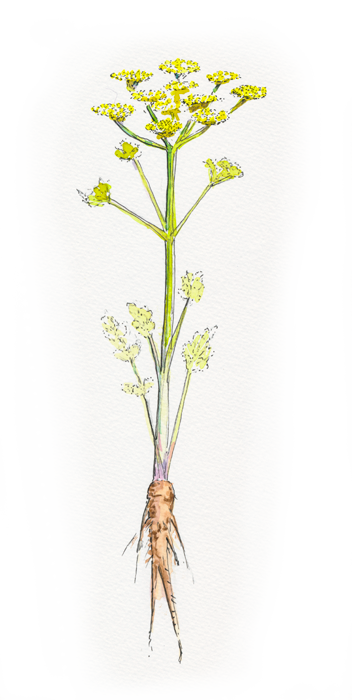Wild Parsnip

ISSN-1059-6518 Volume 27 Number 4
The Invader: Wild Parsnip
By Paul MacMillan, AEMT
Illustrations by T.B.R. Walsh

Pastinaca sativa
Danger: Stay away from this invader: wild parsnip in our woods. Wild parsnip juice and ultraviolet light lead to burned skin.
Wild parsnip is also called Pastinaca sativa, its scientific name in Latin. The homeland for this eye-catching, tenacious invasive plant is Europe and Asia. It was introduced into this country as a root crop by European settlers in the 17th century, and it escaped colonial gardens, spreading nearly everywhere. The only states currently free from wild parsnip are Florida, Georgia, Alabama, Mississippi, and Hawaii, according to the U.S. Department of Agriculture.
You may ask what does it look like? It is a member of the carrot family. Wild parsnips are typically biennials, but, on occasion, they can become perennials. The plant will form a rosette of basal leaves for the first year, then flowering the second year. It flowers primarily from May through July.
In its first summer the wild parsnip will have a rosette of leaves close to the ground. The plant is anchored in the soil by a long, thick, edible taproot, much like a carrot. If the growing conditions are right in the second summer, meaning soil impregnated with limestone or lime and in a sunny area, the plant will send up a single flower stalk that will produce hundreds of tiny yellow flowers. They form flat-topped, umbrella-like clusters called umbels. The stalks on the plant can grow up to 4 feet tall or higher. Wild parsnip plants produce a large number of seeds, which contribute to their persistence and spread.
Simple contact with this plant will cause you no harm unless you have supersensitive skin. The danger comes if you damage the plant, and you get the toxic plant juice on your skin. The wild parsnip plant parts contain chemicals called furocoumarins which cause “phytophotodermatitis.” The combination of this plant juice on your skin and some ultraviolet light will produce a burn on your skin.
When your skin comes into contact with these furocoumarins from wild parsnip the chemicals are absorbed into your skin. These chemicals are then stimulated by ultraviolet light, which is present during sunny and cloudy days, causing them to bind with nuclear DNA and cell membranes. This process begins the breakdown of cells and skin tissues. This reaction will take time before the actual skin damage is visible.
